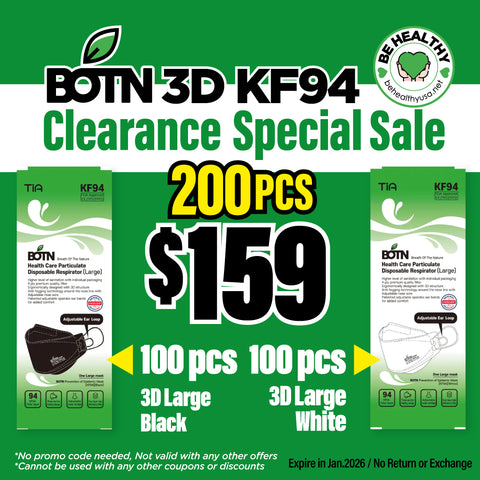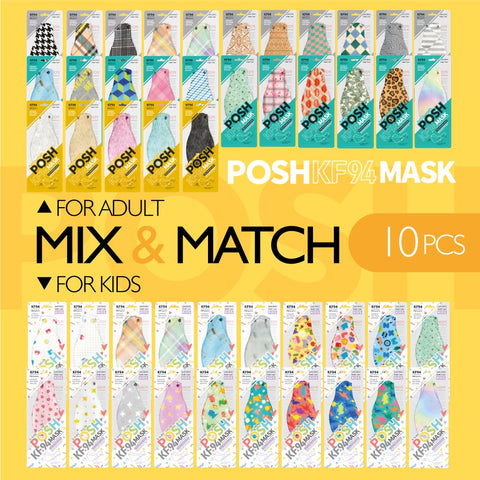KF94 & KN95: a 2025 Update on Key Differences

In public spaces and travel, wearing a medical-grade mask adds a layer of protection. KF94 and KN95 are both high-filtration respirators similar to N95. They’re manufactured and certified in different countries, so there are some key differences. KF94 masks are made in South Korea and certified by the Korean Ministry of Food and Drug Safety. KN95 masks are made in China and certified under China’s GB standard. In practice, both block at least 94–95% of particles with some KF94 models reaching up to 99.5% efficiency in lab tests. What sets them apart is fit and construction. Below we compare origins, design, comfort, and use-cases to help you choose which mask is best for you.
Standards & Certification
KF94 (South Korea)
“KF” stands for Korean Filter. All KF94 respirators are produced under strict Korean government standards. They are tested and approved by Korea’s Ministry of Food and Drug Safety (MFDS), so genuine KF94 masks must meet a 94% filtration standard. Because of this oversight, real KF94s are rarely counterfeit.
KN95 (China)
“KN” refers to China’s national standard. KN95 masks must filter ≥95% of particles under the GB 2626 standard. However, Chinese manufacturers mostly self-certify compliance. In other words, any company can produce KN95 masks and claim they meet the standard (and indeed many do). This system means quality can vary. Some KN95 products on the market have been found to be substandard or counterfeit. (Tip: always look for proper markings like “GB 2626-2019” on a KN95.)
Trusted Filtration Standards: At their core, both KF94 and KN95 are legitimate, high-performance respirator standards. They rely on multiple layers of nonwoven and melt-blown materials to filter out harmful particles. While there’s a technical difference of 1% in their minimum filtration ratings (94% for KF94 vs. 95% for KN95), this gap is negligible in real-world use. In fact, many reputable KF94 brands—such as BLUE KF94 and BOTN KF94—consistently demonstrate filtration rates around 99% in lab testing.
Proven Filtration Technology
Both KF94 and KN95 are high-performance respirators designed to filter airborne particles using multiple layers of nonwoven and melt-blown materials—similar to those used in N95 masks.
Real-World Use: Minimal Difference
Ultimately, protection depends more on fit and mask authenticity than a marginal difference in filter rating. When worn correctly, both KF94 and KN95 outperform loose-fitting surgical or cloth masks by a wide margin.
Design & Fit Differences
KF94 and KN95 masks can look quite different on your face. The KF94’s hallmark is a 3D style boat shape: a 3-panel design that folds outward to cup your nose and mouth. This enveloping design has side flaps to hug the cheeks, which helps create a seal without pressing directly on your lips. In contrast, the classic KN95 often has a flat V-shape; it protrudes in front of the nose and then comes in toward the cheeks.
KF94: 3D multi-panel shape fits many face shapes (the fold and side panels provide extra space). The mask typically includes an adjustable metal nose wire, and many brands (e.g. POSH KF94, BOTN KF94) use adjustable ear loops or toggles so you can tighten the fit. This makes it easy to customize the KF94 on your face (great for smaller faces or kids). The 3D style boat shape also means the mask material stays away from your mouth, giving more breathing room.
KN95: Simpler folded shape with a center seam. Ear loops are usually fixed and not adjustable. The tight fold seals well but leaves less gap around the mouth. KN95s are designed for one-size fits all. If they fit your face well, they seal extremely tightly on all sides; if not, leakage can occur. (Some KN95 masks now offer 3D multi-panel shape designs like the KF94 masks.)
Fit Matters: Both masks rely on a good seal to work. KF94’s flexible design often conforms comfortably around the face, while KN95s provide a firm seal but with less give. Many users find KF94 easier to wear for long periods because it can be easily adjusted and doesn’t collapse inward. Both should fit without gaps at the cheeks and nose. Tip: Look for adjustable features (nose bars, clip-on extenders) to improve any mask’s fit.
Comfort & Breathability
KF94 Comfort: Most people report that KF94 masks feel easier to breathe through and less claustrophobic. The 3D design creates a pocket of air in front of your nose and mouth so it doesn’t pull onto your skin when you inhale. KF94s tend to be lightweight (many models feel like a soft, airy fabric on your face) and don’t trap heat as much. They also sit off your nose and cheeks, which helps prevent fogging if you wear glasses (there’s room at the top for frames). For example, one analysis notes KF94 masks “do not pull into the mouth when the wearer is talking or breathing”.
KN95 Feel: Because KN95 masks feel thicker and tighter, they can feel a bit stiffer. As one guide notes, KN95 “requires a slight effort to breathe normally”. In practice, this is usually only noticeable during heavy exertion; for everyday use it’s still comfortable by many.
Key Point: Both mask types can be worn safely by the general public. Comfort differences are largely personal. If you need a mask for long shifts, flights, or hot environments, the KF94’s extra breathing space and lighter feel may make it more comfortable.
Bottom line
Both KF94 and KN95 offer excellent protection when worn properly. If comfort and certified quality matter most, choose KF94. If you need an affordable option and can verify authenticity, KN95 works well too.
Always focus on fit—no mask works if it leaks.
Sources: Information compiled from Korean and Chinese mask standards, expert analyses, and CDC guidelines. All statistics and recommendations above are based on official mask certification rules and published studies on mask use.















